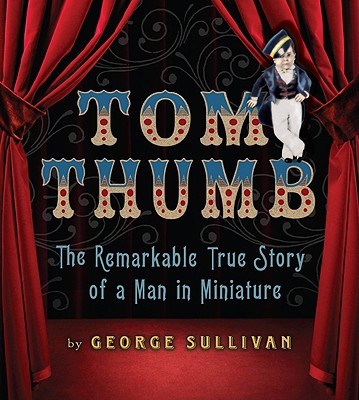 TOM THUMB: THE REMARKABLE TRUE STORY OF A MAN IN MINIATURE
TOM THUMB: THE REMARKABLE TRUE STORY OF A MAN IN MINIATURE
I just finished an advance reading copy of TOM THUMB: THE REMARKABLE TRUE STORY OF A MAN IN MINIATURE by George Sullivan (Clarion; February, 2011; 208 pages; grades 5–9).
Writing non-fiction is like putting together the pieces of a puzzle, says author George Sullivan… “I like nonfiction because I’m a very curious person, and the research that I do I find introduces me to new worlds,” he said. “I’m always interested in finding out what people were really like—how they live, what the family life was like, what motivated them.” (full article here)
I think he succeeds in conveying that sense of curiosity and wonder to his readers, and TOM THUMB should be of great interest to middle-graders for both pleasure reading and researching reports.
In TOM THUMB, Sullivan pieces together the puzzle behind the real-life story of Charles Sherwood Stratton (a dwarf who would later become famously known as Tom Thumb), as well as those of P.T. Barnum and Tom Thumb’s wife, Lavinia.
Written as a narrative, the text chronologically follows Tom Thumb’s life and beyond, weaving an interesting biography and tale of history and showmanship. Sullivan treats his subject with careful dignity and respect.
In addition to the story itself, librarians, teachers, and researchers will appreciate the attention to backmatter, including acknowledgements, about the sources, end notes, bibliography, books and articles list, and an index.
In my mind, the book also raises some interesting opportunities for discussions in classrooms and children’s book clubs:
- The book makes it clear that Tom Thumb apparently enjoyed playing his roles and living life as a performer in the public eye, but others, most notably Barnum and Tom Thumb’s own parents, also profited from his on-stage antics. At what point does it constitute exploitation to treat people this way? What factors might have made it acceptable historically? How is it different today? What types of exploitation, if any, still exist today? Should they be banned?
- The book reveals Barnum’s skills in self-promotion, marketing, and knowing what audiences wanted and were willing to pay for. It also reveals several knows cases of “humbuggery,” or instances where he knowingly deceived audiences to draw bigger crowds and more profit. Is this behavior acceptable for a “showman?” What might “humbuggery” look like today, and how do we try to protect consumers from it? Are we successful? How can we be on the lookout for “humbuggery” in today’s media?
Sullivan has written more than 100 books for children, and he’s still writing in his 80s. He shared some of his tips here, including:
“I write very early in the morning, when my mind is fresh and when I know I’m not going to be interrupted by the telephone or visitors or whatever might occur during the day,” he said. “I do a great deal of work in the early morning hours.”
And,
“You take the project and you break it into pieces,” he said. “You have an outline that breaks it down into different categories. Then you research each of these pieces, instead of trying to do everything all at once.”
Good advice. And Sullivan has certainly built a book, and a career, worth emulating.
